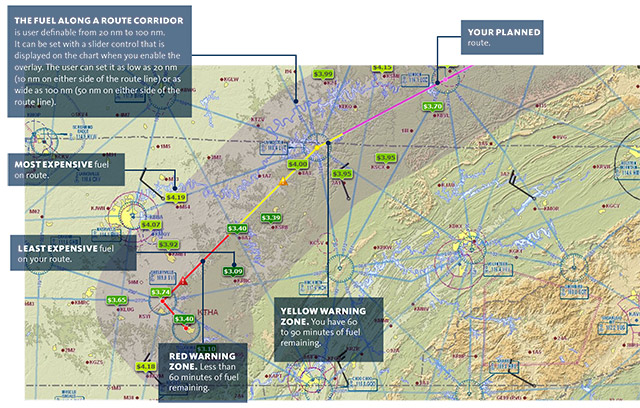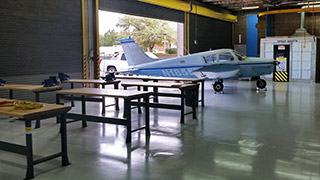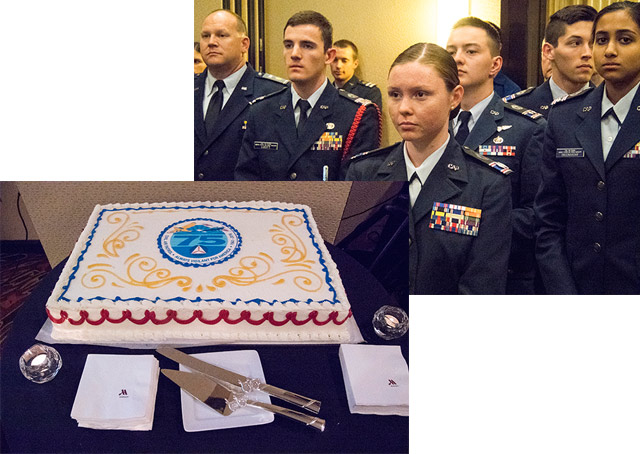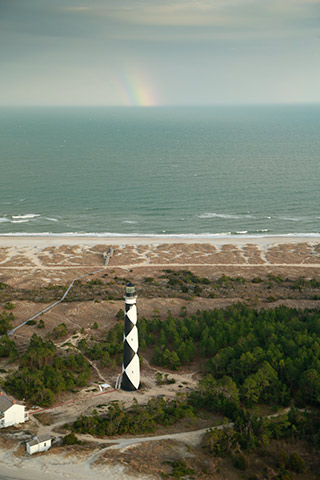
Flying wild Alaska. Great adventures await pilots in the Alaskan outback, as Editor in Chief Tom Haines discovered recently. In a 1954 Cessna 180 Skywagon, he explored Wrangell-St. Elias National Park, flying low and slow over the Chitina River with Iditarod pilot Joe Pendergrass. Pendergrass uses his 180 for aerial support of the annual sled dog race in Alaska.
What: Cessna 180
Where: McCarthy, Alaska
Photographer: Mike Fizer
AOPA News
Dynamic ‘destination’ planner debuts
AOPA offers exciting flight-planning tools
By Julie Summers Walker

Going on a long cross-country during which you’ll need to make a fuel stop? AOPA’s Flight Planner, powered by Jeppesen, makes fuel planning simple.
A color code along your route line identifies legs where you’ll have 60 to 90 minutes of fuel remaining—and another feature shows color-coded fuel prices along the route. Yellow and red colored “zones” on the magenta route line identify recommended fuel stops. The yellow caution zone represents the segment of your route where you will have 60 to 90 minutes of fuel remaining; the red warning zone represents the segment of the route where you will have less than 60 minutes of fuel remaining. The AOPA Air Safety Institute recommends a 60-minute fuel reserve.
The fuel-planning warning zones will consider winds aloft at your planning altitude and at your time of departure. The zones also consider the climb and descent fuel required, based on the values entered into your aircraft profile. If your departure time is too far in the future and outside a valid winds-aloft forecast period, the zones will be calculated as a no-winds route. Special warnings are presented when winds aloft are not being considered in the calculations.
AOPA’s Eric Rush, manager of the flight planning team, declares the AOPA Flight Planner “awesome.” Previously you might have wondered where you were going to stop for fuel, but now, according to Rush, “We identify the available stops—and we find you the best deal” on fuel prices. A video tutorial is offered on AOPA Online (www.aopa.org/aifp).
The flight planner works with two of the leading electronic flight bags—Foreflight Mobile and WingX Pro 7. Send your route in an email, which has links to allow you to open your route in your EFB.
More clever features are in the works from the AOPA flight-planning team, Rush says. Stay tuned for more options to be added to this exciting “destination” planner, he says.
Grab the wrenches
Affordable aviation maintenance program opens in Florida
By David Tulis
 Florida’s Escambia County School District has certified a new two-year aviation maintenance program at Pensacola’s George Stone Technical Center.
Florida’s Escambia County School District has certified a new two-year aviation maintenance program at Pensacola’s George Stone Technical Center.
Instructors Bill Davis and Kyle Cook will be teaching students how to service, maintain, and repair aircraft systems, airframes, powerplants, and other components. Davis earned his maintenance chops during a 33-year stint in the U.S. Air Force. “I’m primarily a propulsion guy from my duties with the Air Force but I learned all the other systems out of necessity,” Davis said. He added that Cook “was priceless” in helping shape the new school’s syllabus and curriculum.
School principal Thomas Rollins told the Pensacola News Journal that the inaugural spring class will have 25 students per instructor. Rollins said financial aid for the aircraft maintenance program will be available for qualified students, and he estimated the program would cost between $6,000 and $7,000.
Davis said students will use their new skills on a single-engine, propeller-driven Piper Cherokee and on a North American T–39 (Sabreliner) U.S. Navy jet trainer, both of which were donated to the program.
“The Sabreliner was the last serviceable T–39 airframe that was, quite literally, a flying aircraft two weeks before we got it, so we were real fortunate there. We also have a Lancair Legacy donated to us by a Delta pilot because he didn’t have the time to finish building the kit, so it’s still in pieces,” said Davis.
He expects to drag a pair of broken aircraft out of the nearby Florida pines so students can work on them, too. “Hurricane Ivan damaged a Cessna 150 and a Navion and they’ve been sitting there since 2004, but first I have to figure out a way to get them out of the woods.”
Although the adult-oriented technical school doesn’t have an airport, it is close to Ferguson Field. The airfield has an agreement for George Stone students to do taxi checks and engine runups there. The school’s campus is about 15 miles from Naval Air Station Pensacola, headquarters for the U.S. Navy’s Blue Angels flight demonstration team.
“We’re truly hoping for big things here in our area and a chance to start training the next generation of aircraft technicians. This has certainly been a collaborative effort with the school district, our business partners, and community. Without the support of all of them we wouldn’t have gotten this to go as far as it has,” Davis said.
FAA news
Student pilot certificate changes
Review AC for guidance
Since April 1, it is no longer possible to receive a student pilot certificate from an aviation medical examiner (see “Paper to Plastic,” April 2016 Flight Training). The FAA’s Advisory Circular 61-65F explains how the process of applying for and issuing student pilot certificates has changed.
Most applicants will apply through a flight instructor, who must use the FAA’s web-based Integrated Airman Certification and/or Rating Application (IACRA) or submit Form 8710-1 to the FAA. The agency will mail the certificate within approximately three weeks of the application date. It also will be possible to apply through FAA inspectors at a flight standards district office, designated pilot examiners, or airman certificate representatives from a Part 141 flight school.
The AC provides guidance for flight instructors on how to register to use the IACRA system and how to issue an endorsement prior to solo. It also gives guidance on how to ensure an applicant is eligible for the student pilot certificate.
Although the changes primarily address the revised student pilot certificate application process, a number of additional changes were made. There is increased emphasis on ensuring that pilot applicants satisfy English language proficiency. The AC also expands guidance on determining the expiration date of a flight instructor certificate renewal, and provides examples.
“AOPA will monitor the FAA’s response to applications to ensure that student pilot certificates are issued as soon as practical and that students are not being held back from soloing and completing their flight training,” said Justin Barkowski, AOPA director of regulatory affairs. AOPA also has requested that the FAA establish a method for allowing a student pilot to solo on his or her sixteenth birthday (or fourteenth birthday in the case of gliders), an option not available under the revised application process.
Milestones
CAP begins 75th anniversary celebration
Organization founded in December 1941

Many cadets displayed their blue dress uniforms for the kickoff of the Civil Air Patrol's seventy-fifth anniversary celebration in Crystal City, Virginia.
The Civil Air Patrol began its seventy-fifth anniversary celebration by doing what it does best: working behind the scenes to support scores of mentors and cadets keeping a fleet of 550 aircraft in the sky for its 56,000 volunteers.
The anniversary kickoff reception in Crystal City, Virginia, saw about 300 Civil Air Patrol members, leaders, and volunteers packed into a room as speeches and accolades were delivered to the corps, with many proudly wearing their dress uniforms with insignias and awards displayed across their chests.
A three-foot-long cake decorated with white icing, blue and gold trim, and a pair of high-flying observation airplanes helped to initiate the yearlong festivities. The continuing celebration will honor CAP’s evolving roles its inception on December 1, 1941, during World War II. President Harry S. Truman signed a measure incorporating the unit in 1946 and that’s when the organization officially became the civilian auxiliary of the U.S. Air Force.
Since then, the Civil Air Patrol has helped conduct countless searches, rescues, and training missions while building up enthusiasm for flight and an understanding of aviation for its male and female cadet participants.
The organization’s national commander, Maj. Gen. Joe Vazquez, said the patrol was one of the first military arms to accept both men and women into its ranks. In 1947 the patrol worked closely with the U.S. Army Air Forces to recruit 17-year-old men into the highly successful Air Corps Enlisted Reserve, who would be called to duty after reaching 18. “Female cadets, in turn, were recruited into the Women’s Army Corps,” reads the organization’s historical archive.
Vazquez said that although the patrol’s mission has evolved over the years, it has never strayed far from its original roots.
“We’ve got the largest number of Cessnas in the world in any one organization that controls a fleet [of airplanes], and we have it on purpose. We use the skills of our volunteer pilots and volunteer aircrews to serve America with disaster relief flying, search and rescue, and other assistance missions to our Air Force partners, and various relief agencies,” Vazquez said.
He said the cadet program is one of the Civil Air Patrol’s mainstays. “The cadets are styled in a similar fashion to Junior ROTCs but the difference is our cadets volunteer to be CAP members—it’s not [offered] in the schools. They have to seek us out, so we have highly motivated youth.” Cadets typically meet at airports after school one evening per week to delve into aviation concepts, and on weekends they participate in flying during search training missions.
USAF helps fund CAP encampment programs
The U.S. Air Force will continue to help fund the Civil Air Patrol’s popular weeklong encampment program for aviation-minded high school students. Nearly 7,200 cadet campers participated in the 2015 program, including about 1,000 cadets who were eligible for economic assistance grants that helped cadets with tuition and uniforms.
Encampments provide ways for kids to advance in rank, with classes in leadership, physical fitness, and life skills.
“The experiences the cadets had at the encampments—developing leadership skills, investigating aerospace sciences and career options, and solidifying their moral character—were life-altering events for these young Americans,” said Gen. Mark A. Welsh III, U.S. Air Force chief of staff.
Welsh said the program supports the Air Force’s goals of inspiring character; diversity; fitness; and science, technology, engineering, and math (STEM) development.
Maj. Gen. Joe Vazquez, CAP’s national commander, said cadets who attended encampments achieved more and advanced further in the cadet program. “This learning experience is very important for the cadets, their families, their communities, CAP, and, in years down the line, for America,” he said. –DT
Heading to the beach
Join AOPA in Beaufort, North Carolina, this month
 The 2016 AOPA Fly-In season kicks off with a visit to the beach. Budget Travel magazine called Beaufort, North Carolina, the “Coolest Coastal Town in the United States.” Plan to join us May 20 and 21 at Michael J. Smith Field (MRH) for all of the events and exhibits that have become synonymous with an AOPA Fly-In.
The 2016 AOPA Fly-In season kicks off with a visit to the beach. Budget Travel magazine called Beaufort, North Carolina, the “Coolest Coastal Town in the United States.” Plan to join us May 20 and 21 at Michael J. Smith Field (MRH) for all of the events and exhibits that have become synonymous with an AOPA Fly-In.
AOPA Fly-Ins are for passionate GA pilots and enthusiasts and their friends and families. With exhibits, displays, great speakers, and aircraft, you’ll see all the latest technologies, find ways to get the most out of flying, and learn how other AOPA pilots fly better and safer—all in a historic and coastal airport environment of fun, food, and friendship.
Friday night features a Barnstormers Party with dinner and a country music band. Saturday starts with a pancake breakfast and ends with an ice cream social, with a lunch of local fare and a whole lot of fun in between.
At the AOPA Village, let AOPA staff help you fly better, safer, and cheaper with our amazing benefits and services. Pick up a hat, T-shirt, or souvenir at the AOPA Store. It’s all free to attend. Just RSVP online (www.aopa.org/fly-ins) to tell us you’re coming!



